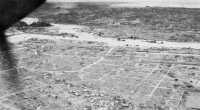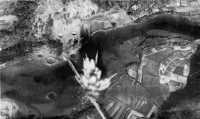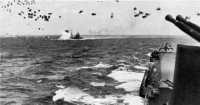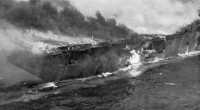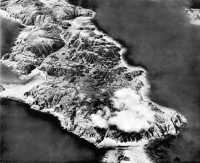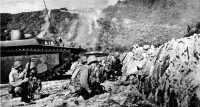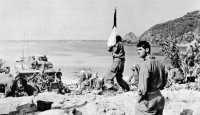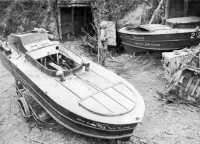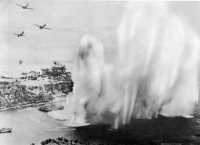Chapter 2: Invasion of the Ryukyus
Operations preliminary to the landing on Okinawa were as protracted and elaborate as the tactical and logistical planning. From October 1944 to April 1945 American forces from the Pacific Ocean Areas, the Southwest Pacific Area, and the China Theater conducted an intensive campaign to neutralize Japanese air and naval strength.1 In the last week of March, while the Kerama Islands were being seized, the Navy concentrated on a furious bombardment of the main target. Before the troops for the assault mounted out American forces had invaded Luzon and Iwo Jima.
Preliminary Neutralization of Enemy Strength
The first attack on Okinawa was made by Vice Admiral Marc A. Mitscher’s Fast Carrier Task Force, operating as part of the Third Fleet, in the preliminary operations for the landings on Leyte. Nine carriers, 5 fast battleships, 8 escort carriers, 4 heavy cruisers, 7 light cruisers, 3 antiaircraft cruisers, and 58 destroyers arrived off Okinawa early on 10 October. Admiral Mitscher made every effort to achieve surprise. The force followed the track of bad weather caused by a typhoon moving toward Okinawa from the southeast. A smaller force of cruisers and destroyers made a diversionary attack on Marcus Island, 1,500 miles to the east, in such a way as to simulate a large force. Aircraft based on the Marianas intensified attacks on Iwo Jima, to hamper searches from that direction, and flew interdiction patrols ahead of the Third Fleet forces.
Wave after wave of carrier planes swept over Okinawa shortly after dawn of 10 October. The first strikes bombed, rocketed, and strafed airfields at Yontan, Kadena, Ie Shima, and Naha. Later waves made intensive attacks on shipping, installations, harbor facilities, and similar targets. The attack continued
throughout the day. Many enemy aircraft were caught on the ground, dispersed and revetted, but only a few in the air. A fighter-bomber from the Bunker Hill dropped a bomb between two midget submarines moored side by side. Other islands in the Ryukyus were reconnoitered and attacked, including Kume, Miyako, Amami-O, Tokuno, and Minami.
The attack was one of the heaviest delivered by the Fast Carrier Force in a single day up to that time. In 1,356 strikes, the planes fired 652 rockets and 21 torpedoes and dropped 541 tons of bombs. Naha was left in flames; four-fifths of the city’s 533 acres of closely built-up area was laid waste. Twenty-three enemy aircraft were shot down and 88 more destroyed on the ground or water. Twenty cargo ships, 45 smaller vessels, 4 midget submarines, a destroyer escort, a submarine tender, a mine sweeper, and miscellaneous other craft were sunk. “The enemy is brazenly planning to destroy completely every last ship, cut our supply lines, and attack us” was the gloomy observation of a Japanese soldier on the island on that day.2
Admiral Mitscher’s estimate of results was probably conservative. A Japanese Army report on the attack listed in addition a destroyer and a mine sweeper as sunk. According to the report, almost 5,000,000 rounds of machine-gun ammunition and 300,000 sacks of unpolished rice were among the supplies destroyed. The report noted that antiradar “window” had been used by the Americans, and that propaganda leaflets had been dropped. Nowhere did the Japanese report mention one of the most significant accomplishments of the task force during the day – photographic coverage of important areas throughout the Ryukyus.3
Okinawa was not assaulted again until 1945, when carrier planes raided the Ryukyu and Sakashima Islands on 3 and 4 January during a heavy attack on Formosa by the Fast Carrier Task Force. The primary objective of the task force was the destruction of enemy air strength on Formosa in preparation for the invasion of Luzon, and the attack on Okinawa was limited in extent because of the long distance the fighters had to fly to the target. On 22 January, Admiral Mitscher’s carrier force moved a second time against the Ryukyus, with the primary mission of photographing the islands. Unfavorable weather interfered with some of the sorties, but pilots obtained photographic coverage of 80
percent of priority areas and attacked ground installations, aircraft, and shipping. The operations were small compared to those of 10 October but to the enemy they must have seemed impressive. A Japanese superior private in the infantry wrote indignantly in his diary on 22 January:
Grumman, Boeing, and North American Planes came over one after another continuously. Darn it, it makes me mad! While some fly around overhead and strafe, the big bastards fly over the airfield and drop bombs. The ferocity of the bombing is terrific. It really makes me furious. It is past 1500 and the raid is still on. At 1800 the last two planes brought the raid to a close. What the hell kind of bastards are they? Bomb from 0600 to 1800! I have to admit, though, that when they were using tracers this morning, it was really pretty.4
On 1 March the Fast Carrier Task Force, now operating as Task Force 58, a part of Admiral Spruance’s Fifth Fleet, delivered another strike on the Ryukyus at the end of a 3-week battle cruise in Japanese home waters which included an attack on Tokyo. Sweeping down the long Ryukyu chain, American planes hit Amami, Minami, Kume, Tokuno, and Okino as well as Okinawa. Cruisers and destroyers shelled Okino Daito, 450 miles from Kyushu, in the closest surface attack to the Japanese homeland made by the fleet up to that time. The carrier planes sank a destroyer, 8 cargo ships, and 45 more craft of various sizes, destroyed 41 enemy planes, and attacked airfields and installations, particularly in the Okinawa Group. Enemy opposition was meager and American losses were small.
During February and March 1945, aircraft based in the Southwest Pacific and in the Marianas made almost daily runs over the Ryukyus and adjacent waters. Army and Navy search planes and patrol bombers hunted the waters for Japanese shipping and helped to isolate Okinawa by destroying cargo vessels, luggers, and other craft plying between Okinawa and outlying areas. One or two bombers flying high over Okinawa became so familiar a sight to the Japanese that they called it the “regular run” and dispensed with air raid alarms.5 During March American submarines also tightened the shipping blockade around the Ryukyus.
On 14 March 1945, Task Force 58 steamed out of Ulithi and headed north. Its objective was the Inland Sea, bounded by Kyushu, western Honshu, and Shikoku; its mission was to prepare for the invasion of the Ryukyus by attacking
Preliminary bombardment of Okinawa and supporting islands began months in advance of the landings. Naha (above) was a prize target because of its port installations and was leveled long before the invasion. Also important were bridges (below) along the island’s lines of supply.
Japanese Kamikaze attacks were a constant menace to the American fleet. Here a Kamikaze plane, falling short of its target, plunges into the sea after being riddled by antiaircraft fire from an American cruiser
But the aircraft carrier Franklin (below) was not as fortunate. Hit off Kyushu by two 550-pound armor-piercing bombs, the Franklin’s fuel, aircraft, and ammunition went up in flame; more than a thousand of her crew were lost. Gutted and listing badly, the carrier limped back to New York for repairs
airfields and naval bases in the Japanese homeland. The formidable task force was composed of 10 large aircraft carriers, 6 smaller carriers, 8 fast battleships, 16 cruisers, and dozens of destroyers and other vessels; included were famous names like Hornet, Yorktown, Enterprise, New Jersey, and Missouri.6
As Task Force 58 neared Kyushu on 17 March, it was spotted by Japanese search planes but was not attacked. At dawn on the 18th the destroyers formed two radar patrol groups, one 30 miles north and the other 30 miles west of the main force, each with carrier-based fighter protection. At 0545, when Task Force 58 was about 100 miles east of the southern tip of Kyushu, the first fighters took off from their carriers and headed for Kyushu airfields. Within an hour more fighters were launched, then the bombers and torpedo bombers. During the forenoon American planes attacked aircraft and fields near the coasts of Kyushu. When the enemy air opposition proved ineffective, the planes were ordered to strike farther inland, at targets originally scheduled for the next day. The move was profitable; during the day 102 aircraft were shot down, 275 more on the ground damaged or destroyed, and hangars, shops, and other airfield installations heavily bombed.
The Japanese counter-attacked during the day. Their attack was not heavy, but it was carried out in an aggressive and determined manner. Single enemy aircraft using cloud cover effectively launched bombing attacks on American carriers. Radars were not of much help, but visual sightings by destroyers were invaluable. Although patrol planes shot down twelve of the enemy, and antiaircraft fire accounted for twenty-one more, the Yorktown and Enterprise were hit by bombs. Fortunately, damage to the former was minor, and the bomb that hit the Enterprise failed to explode. Both could continue flight operations.
The next day, 19 March, Admiral Mitscher concentrated the attack on the enemy warships at Kobe, Kure, and Hiroshima in western Honshu, as well as on the airfields in Honshu and Shikoku. Major Japanese fleet units, including the battleship Yamato, were at Kure and Hiroshima harbors. The attack against the enemy fleet was only moderately effective, mainly because of extremely heavy and accurate antiaircraft fire. One group alone lost thirteen planes over Kure. The Yamato was slightly damaged, an escort carrier severely damaged, and fourteen other warships damaged in varying degrees. Merchant ships and coastal vessels were sunk or damaged in the Inland Sea.7
Soon after the first planes were launched on 19 March, enemy aircraft appeared over Task Force 58, concentrating their attack as usual on the carriers. Two 550-lb. bombs hit the Franklin while she was in the course of launching a strike. She burned fiercely amid shattering explosions and enveloping clouds of black smoke, finally becoming dead in the water. A bomb hit the Wasp and exploded between her second and third decks, but the fire was quickly put out and the carrier was able to work her aircraft within an hour. The weather was perfect for the enemy: a thin layer of clouds at 2,500 feet. Antiaircraft gunnery was, however, excellent. Six Japanese planes attacked one group, coming in at cloud level at an angle of 45 degrees; all six were blown to pieces.
Task Force 58 retired during the afternoon of 9 March. Carriers covered the burning Franklin, which was being towed at five knots, and launched fighter sweeps against Kyushu airfields in order to disrupt any planned attack on the force as it withdrew slowly south. Eight enemy planes attacked in the evening but were intercepted 80 miles away; five were shot down. The total number of Japanese planes shot out of the air during the day by planes and antiaircraft fire was 97, and approximately 225 additional enemy aircraft were destroyed or damaged on the ground. Installations at more than a score of air bases on Honshu, Shikoku, and Kyushu were left in ruins by the operations of the day.
Japanese “bogeys” shadowed Task Force 58 on 20 March, and enemy planes attacked during the afternoon and evening. The Enterprise was hit by American gunfire which started a fire. Eight planes were destroyed and flying operations were halted. A plane narrowly missed the Hancock and hit and crippled a destroyer. The Japanese delivered an 8-plane torpedo strike against the force during the night, without success. On the 21st the enemy launched a final heavy attack on the retiring ships, with a force of 32 bombers and 16 fighters. Twenty-four American fighters intercepted the enemy planes about sixty miles from the force and quickly shot down every enemy plane, with the loss of only two American fighters. Task Force 58 met its supply ships south of Okinawa on 22 March, and spent a busy day fueling, provisioning, and taking on replacement pilots and aircraft, in preparation for the decisive phase of the campaign soon to come. In the entire course of its foray from 18 to 22 March, Admiral Mitscher’s force had destroyed 528 enemy planes, damaged 16 surface craft, and hit scores of hangars, factories, warehouses, and dock areas. The success of the operation was indicated by the subsequent failure of the Japanese to mount a strong air attack for a week after the American landing on Okinawa.
Seizure of the Kerama Islands
The first landings in the Ryukyus were on the Kerama Islands, fifteen miles west of Okinawa. The boldly conceived plan to invade these islands six days prior to the landing on Okinawa was designed to secure a seaplane base and a fleet anchorage supporting the main invasion. An additional purpose was to provide artillery support for the Okinawa landing by the seizure of Keise Shima, eleven miles southwest of the Hagushi beaches, on the day preceding the Okinawa assault. The entire operation was under the control of the Western Islands Attack Group. The force selected for the landings in the Keramas was the 77th Division, commanded by Maj. Gen. Andrew D. Bruce; the 42nd Field Artillery Group was chosen for the landing on Keise Shima.8
Steaming from Leyte, where the 77th Division had been engaged in combat since November 1944, the task force moved toward the objective in two convoys. The as LSTs, 14 LSMs, and 40 LCIs, organized into a tractor flotilla with its own screen, left on 20 March. Two days later twenty transports and large cargo vessels followed, screened by two carrier escorts and destroyers. En route, the training begun on Leyte was continued. Operational plans were discussed and the men were thoroughly briefed with the aid of maps, aerial photographs, and terrain models. Booklets on habits, customs, government, and history of the Okinawans were distributed. After an uneventful voyage, broken only by false submarine alarms, the entire task force arrived on 26 March in the vicinity of the Kerama Islands.
Naval and air operations against the Keramas had begun two days earlier. Under the protection of the carriers and battleships of Task Force 58, which was standing off east of Okinawa, mine sweepers began clearing large areas south of the objective area on 24 March. On 25 March Vice Admiral William H. Blandy’s Amphibious Support Force arrived, and mine sweeping was intensified. By evening Of 25 March a 7-mile-wide lane had been cleared to Kerama from the south and a slightly larger one from the southwest. Few mines were found. Underwater demolition teams came in on the 25th and found the approaches to the Kerama beaches clear of man-made obstacles, though the reefs were studded with sharp coral heads, many of which lay only a few feet beneath the surface at high tide and were flush with the surface at low tide.9
While the demolition teams surveyed the approaches, observers from 77th Division assault units studied their objectives. A fringing reef of irregular width surrounds each island. The coasts of the islands are generally steep and irregular. Narrow benches of coral rock lie along the coasts in many places. The beaches are narrow and are usually bulwarked by 4-foot sea walls. The only beaches of any considerable length are at the mouths of steep valleys or within small bays. All but the smallest of the islands are for the most part masses of steep rocky slopes, covered with brush and trees and from about 400 to 800 feet in height. Wherever possible the inhabitants grew sweet potatoes and rice on the terraced slopes of the hills and in small valley flats near the beaches. There are no roads and only a few pack-animal trails. No island in the group is suitable for an airstrip; none can accommodate large masses of troops or extensive base facilities. The military value of the Keramas lies in two anchorages, Kerama Kaikyo and Aka Kaikyo, separated from each other by Amuro Islet, in the center of the group, and bounded on the east by Tokashiki and on the west by Aka, Geruma, and Hokaji. These anchorages enclosed 44 berths, from 500 to 1,000 yards long, ranging in depth from 13 to 37 fathoms.10 (See Map 7.)
Four battalion landing teams (BLTs) of the 77th Division made the first landings in the Kerama Islands on the morning of 26 March. The sky was clear, visibility good, and the water calm. Escorted by Navy guide boats, waves of amphibian tractors moved from LSTs to four central islands of the group – Aka, Geruma, Hokaji, and Zamami. Cruisers, destroyers, and smaller naval craft swept the beaches with 5-inch shells, rockets, and mortar shells. Carrier planes strafed suspected areas and guarded against interference by enemy submarines and aircraft. Amphibian tanks led the amtracks to the beaches.11
The first unit ashore was the 3rd BLT of the 305th Regimental Combat Team (RCT). At 080412 the 3rd BLT hit the southern beaches of Aka, an island of irregular shape, measuring 3,400 by 3,000 yards at its extreme dimensions and rising in a series of ridges to two peaks, one 539 feet and the other 635 feet high. Aka, “Happy Corner Island,” lies near the center of the group. The 200 boat operators and Korean laborers on Aka put sporadic mortar and machine-gun fire on the Americans, without inflicting damage, and then
Terrain in the Kerama Retto was rugged. In particular the coastal terrain was precipitous, appearing formidable to the 2nd BLT, 306 Infantry, 77th Division, as it approached Hokaji Island on 26 March. Below is an aerial view of Tokashiki Island
retreated into the steep central area as the invaders rapidly overran the beaches and the town of Aka.
The next island invaded – and the first to be secured – was Geruma, a circular island five-eighths of a mile in diameter, lying south of Aka. The 1st Battalion Landing Team of the 306th Regimental Combat Team landed on the narrow beach at 0825, meeting no opposition except for long-range sniper fire. Within three hours it wiped out a score of defenders and secured the island. Before the engagement was over, DUKW’s began unloading 105-mm. howitzers of the 304th and 305th Field Artillery Battalions for use in operations scheduled for the next day.
The easiest conquest of the day was that of Hokaji, an island one mile by 800 yards, lying a few hundred yards south of Geruma and linked to it by an encircling reef that follows the contours of the two land masses. The 2nd BLT of the 306th landed on Hokaji at 0921 and secured it without resistance.
At 0900 on 26 March the 1st BLT of the 305th invaded Zamami, initially meeting little resistance. A two-legged, humpbacked island, approximately 5,500 yards long east-west and 400 yards at its narrowest point, Zamami is formed, except for a few low flat areas along the southern coast, by a group of wooded hills which rise about 450 feet. Amtracks carried the troops ashore in a deep bay that cuts into the southern coast. A sea wall fifteen feet from the water’s edge held up the amtracks and forced the men to continue by foot. The assault elements received sporadic mortar and sniper fire until they reached the town of Zamami, just to the rear of the beach. Then a group of Japanese estimated to be of company strength, together with about 300 Korean laborers, fled north from the town to the hills.
It became apparent to General Bruce by late morning of 26 March that the rapid progress of the landing teams would permit the seizure on the first day of an additional island. Accordingly the 2nd BLT of the 307th, a reserve unit, was directed to seize Yakabi, north-westernmost islet of the Keramas, which was nearly oval in shape and a little more than a mile long. At IM 1 the battalion landed on Yakabi and, meeting only slight opposition, quickly overran it.13
On both Aka and Zamami the invading forces met stiffer resistance as they pressed up the steep slopes into the interior of the islands. On Aka a group of Japanese of platoon strength was routed by naval gunfire. During the afternoon the troops killed fifty-eight Japanese in a series of brief skirmishes
on the eastern heights of the island. Though the enemy fought from caves and pillboxes with small arms, he had no effective defense. By 1700 of 26 March two-thirds of Aka was secured; 300 Japanese troops and 400 civilians were still at large on the island.
On Zamami advance elements of the 1st BLT of the 305th pushed up into the high ground during the afternoon without closing with the enemy. From midnight until dawn of the next day, however, groups of Japanese armed with rifles, pistols, and sabers tried to break into the American perimeters near the beach. Company C bore the brunt of the attack, repulsing nine local thrusts supported by automatic weapons and mortars. One American machine gun changed hands several times. In a series of night fire fights that at times developed into savage hand-to-hand combat, the 1st Battalion killed more than 200 of the enemy at a cost of 7 Americans killed and 12 wounded.14
On 27 March the Americans took without opposition Amuro, an islet between the two anchorages and Kuba, the south-westernmost of the Keramas. Fitful action was still in process on Aka and Zamami on the morning of 27 March. On Aka the 3rd BLT of the 305th isolated seventy-five Japanese who were dug in on a ridge and its reverse slope and were fully supported by mortars and automatic weapons. After a period of aerial strafing, bombing, rocketing, and mortar fire, the Americans drove the enemy from their position into the brush. On Zamami patrols of company size reconnoitered the island and eliminated scattered groups of the enemy. One organized position was located but could not be assaulted until the following day, when amtracks blasted frontally the caves where the last Japanese to be found were dug in.
After a preparation by artillery firing from Geruma, the 1st BLT of the 306th landed on the west coast of Tokashiki at 0911 of 27 March, and a few minutes later the 2nd BLT landed to the south of the 1st. Tokashiki was the largest island in the group, six miles long from north to south and averaging about one mile in width. Closest of the islands to Okinawa, it formed the eastern barrier of the Kerama anchorages. Its coasts rise for the most part as cliffs or steep slopes cut by narrow ravines, the hill masses reaching heights of more than 650 feet in the center of the island and at the northern and
southern ends. At the backs of two sheltered bays near the center of the west coast there are two settlements, Tokashiki and Aware; the sandy beaches near these bays were selected by the invaders for the landings.
Operations on Tokashiki followed the pattern of those on the other major islands of the Keramas. Resistance at first was negligible, the Americans being hindered more by the rugged terrain than by the scattered sniper fire. The two battalions abreast drove north over narrow trails. The 3rd BLT of the 306th, initially in reserve, was landed with the mission of clearing the southern portion of the island. By nightfall the 1st and 2nd Battalions were set for the next day’s attack on the town of Tokashiki on the east coast; 3rd Battalion patrols had reached the southern tip of the island.
On the following day, 28 March, the two battalions of the 306th renewed their drive to the north. After a 500-round artillery preparation the troops occupied Tokashiki, which had previously been leveled by air and surface bombardment. The area near the bay was overrun without opposition. The advance continued to the north, meeting only scattered resistance. On 29 March, after the three battalions had sent patrols throughout the island, Tokashiki was declared secured.
By the evening of 29 March all islands in the Kerama Retto were in American hands. In all, combat elements of the 77th had made fifteen separate landings, involving five ship-to-shore movements by LVTs, two ship-to-shore movements by DUKW’s, three ship-to-shore movements by LCVPs with subsequent transfer to LVTs, and five shore-to-shore movements by LVTs. Despite the complexity of the maneuvers, the veterans of Guam and Leyte operated with little confusion. Casualties were low. From 26 to 31 March the 77th killed 530 of the enemy and took 121 prisoners, at a cost of 31 Americans killed and 81 wounded.15
The operations on Aka and Tokashiki had interesting consequences. Although 77th Division patrols scoured the islands, hundreds of Japanese soldiers and civilians managed to evade discovery in caves, ravines, and brush throughout the hilly central parts of the islands. After the Okinawa operation, representatives from Tenth Army tried unsuccessfully to induce the Japanese commander on Aka to surrender. The Japanese soldiers and sailors were not as stubborn, and most of them escaped from the island and surrendered. On Tokashiki teams of Nisei and Japanese officer prisoners negotiated with the Japanese commander, who refused to surrender his garrison of 300 officers and men. He offered, however,
to allow Americans to swim on Tokashiki beaches provided they kept away from the Japanese camp in the hills. Only after many months, when he was given a copy of the Imperial rescript announcing the end of hostilities, did the Japanese commander surrender, claiming that he could have held out for ten more years.16
The capture of the Kerama Islands was followed by the landings on Keise Shima. Lying about eleven miles southwest of the Hagushi beaches and about eight miles west of Naha, the group of four tiny coral islets that make up Keise had an importance in the attack on Okinawa far out of proportion to its size and topography. From Keise 155-mm. guns could command most of southern Okinawa. Employing tactics used with great success on Kwajalein, Tenth Army ordered XXIV Corps artillery to emplace two battalions of 155-mm. guns on Keise to support the attack.
On 26 March the Fleet Marine Force Amphibious Reconnaissance Battalion, attached to the 77th Division, scouted Keise without encountering enemy troops or civilians. On the morning of 31 March a convoy of LSTs and LSMs bearing the 420th Field Artillery Group and attachments arrived off the islets. Over floating caisson docks set up by Seabees the heavy guns and other equipment were unloaded. Twenty-four 155-mm. guns were emplaced on the low, sandy islets, and a cub strip and a bivouac area were established. By dawn of L Day the batteries were ready to execute their mission of firing counterbattery, interdiction, and harassing fires deep into enemy territory.
The guns were set up in full view of the Japanese occupying high ground on Okinawa. General Ushijima ordered a “surprise shelling” of Keise to begin at midnight of 31 March, after which army and navy commands were to dispatch “raiding infiltration units” to Keise, “thereby wiping out the enemy advanced strong point in one blow.”17 For an hour after midnight, Japanese 250-mm. shells exploded on the islets. There were no casualties or damage. The infiltration party never appeared. This attempt to destroy the artillery on Keise was only the first of several, the enemy being keenly aware of the threat offered by the artillery in this flanking position.18
The assault on Kerama and Keise had come as a surprise to the Japanese commanders on Okinawa Gunto. The enemy commanders on Okinawa had
expected that the Americans would land first on the Hagushi beaches and that their ships would deploy just east of the Kerama Islands.19
Since the enemy considered the Keramas as bases for special attack units rather than as defensive positions, there were few prepared defenses on the beaches or inland when the Americans appeared. At one time 2,335 Japanese troops occupied the islands, engaged in installing and operating facilities for the Sea Raiding units. When, in late 1944 and early 1945, the need for combat troops on Okinawa became acute, most of these troops were moved to the larger island. There remained on the Kerama group only about 300 boat operators of the Sea Raiding Squadrons, approximately 600 Korean laborers, and about 100 base troops. The garrison was well supplied not only with the suicide boats and depth charges but also with machine guns, mortars, light arms, and ammunition.20
In Kerama Retto, “Island Chain between Happiness and Good,” the Japanese tradition of self-destruction emerged horribly in the last acts of soldiers and civilians trapped in the hills. Camping for the night of 28 March a mile from the north tip of Tokashiki, troops of the 306th heard explosions and screams of pain in the distance. In the morning they found a small valley littered with more than 150 dead and dying Japanese, most of them civilians. Fathers had systematically throttled each member of their families and then disemboweled themselves with knives or hand grenades. Under one blanket lay a father, two small children, a grandfather, and a grandmother, all strangled by cloth ropes. Soldiers and medics did what they could. The natives, who had been told that the invading “barbarians” would kill and rape, watched with amazement as the Americans provided food and medical care; an old man who had killed his daughter wept in bitter remorse.21
Only a minority of the Japanese, however, were suicides. Most civilians straggled into American positions, worn and dirty. In all, the 77th took 1,195 civilian and 121 military prisoners. One group of 26 Koreans gave up on Zamami under a white flag. On Aka one Japanese lieutenant surrendered voluntarily because, he said, it would be “meaningless” for him to commit suicide.22 A Japanese
Landings In The Keramas, made by the 77th Division, met little opposition. Zamani Island (above) was taken by the 1st BLT, 305th Infantry, some soldiers of which are shown just before the started inland. Amtracks were unable to negotiate the seawall and were left at the beach. Below is a scene on a beach at Tokashiki, captured by the 1st BLT, 306th, on 27 March
Soldier (right) seems puzzled by the absence of opposition
major captured by a patrol on Zamami late in May assisted in efforts to induce Japanese remaining in the islands to surrender.
More than 350 suicide boats were captured and destroyed by the 77th in the Kerama Islands. They were well dispersed throughout the islands, many of them in camouflaged hideouts. These plywood boats were 18 feet long and 5 feet wide. Powered by 6-cylinder Chevrolet automobile engines of about 85 horsepower, they were capable of making up to 20 knots. Two depth charges weighing 264 pounds each were carried on a rack behind the pilot and were rolled off the stern of the boat when released. According to captured instructions, three boats would attack a ship simultaneously, each seeking a vital spot to release its charge. Strictly speaking, manning the boats was not suicidal in the same sense as piloting the Kamikaze planes or the “Baka” bombs. Delay time for the depth-charge igniters was five seconds. According to a Japanese officer, it was considered possible to drop the depth charges against a ship and escape, but the fragility of the boats made survival highly unlikely. As a result, the pilots were promoted two grades upon assignment and received preferential treatment. After completion of their missions they were to receive promotion to second lieutenant; obviously, most such promotions would be posthumous.
From hideouts in the small islands, the “Q-boats” with their charges were to speed to the American anchorages. “The objective of the attack,” General Ushijima ordered, “will be transports, loaded with essential supplies and material and personnel. ... The attack will be carried out by concentrating maximum strength immediately upon the enemy’s landing.”23 The Japanese had carefully mapped out possible assembly areas of American transports and had prepared appropriate routes of approach to each area, especially those around Keise.24 The initial thrust into the Keramas completely frustrated the enemy’s plan. In the opinion of General Bruce, the destruction of the suicide boat base alone was well worth the cost of reducing the Kerama Islands.25
In a campaign that found the Japanese prepared for the major moves of the invading forces, the initial seizure of their “Western Islands” not only caught them off guard but frustrated their plan of “blasting to pieces” the American transports with a “whirlwind” attack by suicide boats.26 The Americans gained
“Suicide Boats” wrecked by their crews were found by the 77th Division as it mopped up in the Keramas. They looked like small speedboats but were poorly constructed and quite slow
These two craft were captured in their cave shelters by American troops on Okinawa. Note booby trap warnings and crude depth charge racks at stern
Softening up the target was the task of the Allied fleet. It stood off Okinawa to place accurate fire on known Japanese installations and to support underwater demolitions teams clearing the beaches. At the same time the fleet’s air arm conducted aerial bombardment
This low-level bombing attack on L minus hit enemy shipping in the mouth of the Bishi River
even more than the Japanese lost. In American hands, this sheltered anchorage became a miniature naval base from which seaplanes operated and surface ships were refueled, remunitioned, and repaired.
Softening Up the Target
While operations were proceeding in the Kerama Islands, Task Force 52, under the command of Admiral Blandy, supervised the specialized tasks that were an essential prelude to the invasion of Okinawa itself-the mine sweeping, underwater demolition work, and heavy, sustained bombardment of the target by ships and aircraft. Task Force 58 stood off to the north and east of Okinawa, ready to intercept any Japanese surface force approaching from the east, while Task Force 52 guarded against enemy attack from the west and against any “express runs” from the north either to reinforce or to evacuate Okinawa. During the day the ships bombarding Okinawa stayed close enough together to be able to concentrate for surface action without undue delay. At night 80 percent of Task Force 52 deployed to the northwest of Okinawa and 20 percent to the northeast. The northwest group was considered strong enough to cope with any surface force which the Japanese could bring against it; the northeast element was to deal with “express runs,” and could count on the support of Task Force 58 if the enemy dispatched a larger, slower, and more easily detected force to the area east of Okinawa. In case of emergency, one force could join the other by passing through the unswept waters north of Okinawa.27
Bombardment of Okinawa began on 25 March when ships of the Amphibious Support Force shelled the southeast coast. The fire was executed only at long range, however, for mine-sweeping operations which had commenced the previous day were still proceeding well offshore. During the following days, as the mine sweepers cleared areas progressively nearer the coast of Okinawa, the bombardment ships were able to close in for heavier and more accurate fire. The Japanese had planted a mine field of considerable strength along the approaches to the Hagushi beaches, and until mine-sweeping operations were completed the American ships could not bring the beaches within range. Not until the evening of 29 March were the approaches to Hagushi and other extensive areas cleared in what Admiral Blandy called “probably the largest assault sweep operation ever executed.” Operating under intermittent
air attack, American mine sweepers cleared about 3,000 square miles in 75 sweeps.
From 26 to 28 March the naval bombardment of Okinawa was at long range; targets were located with difficulty because of the range and occasional poor visibility, and few were reported destroyed. Effective bombardment of the island did not begin until 29 March when battleships, cruisers, destroyers, and gunboats closed the range and hit their objectives with increasing effectiveness. Then for the first time the large concentration of targets in the Naha–Oroku Peninsula area was taken under effective fire. On the 30th heavy shells breached the sea walls along the coast line in many places. Ten battleships and eleven cruisers were now participating in the attack. On 31 March four heavy ships, accompanied by destroyers and gunboats, supported the final underwater demolition operation off the Hagushi beaches. This was completed before noon. Then the ships concentrated on sea walls and on defensive installations behind the beaches. Even at the shortest range, however, it was difficult to locate important targets, and ships had to explore with gunfire for emplacements and similar structures.
During the seven days before L Day, naval guns fired more than 13,000 large-caliber shells (6-inch to 16-inch) in shore bombardment. Including several thousand 5-inch shells, a total of 5,162 tons of ammunition was expended on ground targets. All known coast defense guns in the area were destroyed or severely damaged. The enemy had established a few heavy pillbox-type installations and numerous emplacements along the beaches and farther inland, but most of them were empty. Naval guns fired extensively into cliffs and rocky points overlooking and flanking the beaches to disclose defensive positions such as the enemy had frequently used in the past; few, however, were found.28 By the afternoon of 31 March, Admiral Blandy could report that “the preparation was sufficient” with the exception of certain potentially dangerous installations still in the Naha area. Enemy shore batteries did not open up on ships during the preliminary bombardment.29
Aircraft from Task Force 58 and from the escort carriers flew 3,095 sorties in the Okinawa area prior to L Day. Their primary objective was enemy aircraft based on the islands. Second priority was given to small boats and “amphibian tanks,” which later were discovered to be suicide attack boats
fitted with depth charges. After these, they gave preference to installations such as coastal defense guns, field artillery, antiaircraft guns, floating mines, communications facilities, and barracks areas.
Planes from Task Force 58 concentrated on targets that could not be reached by naval gunfire. Escort carrier aircraft protected the mine sweepers and underwater demolition teams, conducted preliminary attacks against Kerama and Keise, and supported the assault generally. The preliminary air assault got under way on 25 March with bombing, napalm, and rocket attacks on Tokashiki Island in the Keramas and attacks on air installations on Okinawa. On the 26th, 424 sorties were made against suicide boat and midget submarine bases, airfields, and gun positions. On the following day attacks continued on these targets, and barracks areas were also worked over with bombs, napalm, and rockets.
From 28 to 31 March air missions were closely coordinated with projected ground operations as the escort carriers executed missions requested by Tenth Army. Aircraft concentrated on gun positions at scattered points throughout southern Okinawa. They bombed a bridge along the northern shore of Nakagusuku Bay and broke it in ten places. They scored fifteen direct hits with napalm on installations near the Bishi River. Operations against enemy air and naval bases continued. On 29 March carrier planes destroyed 27 enemy planes on Okinawa airfields and probably destroyed or damaged 24 more; planes hit on the ground during the period totaled 80. Barges, wooden boats, and other small enemy craft were systematically gutted. At least eight submarine pens were demolished at Unten Ko on the north coast of Motobu Peninsula.30
Under cover of carrier planes and naval gunfire, underwater demolition teams performed reconnaissance and necessary demolitions on Keise, on the demonstration beaches of southeastern Okinawa, and on the Hagushi landing beaches. Planes made strafing, bombing, and rocket runs on the beaches, and smoker planes, where needed, concealed the teams with smoke. Three lines of ships, increasing in fire power from the beach out, gave the underwater demolition teams formidable support. LCI(G)s (Landing Craft, Infantry, Fire Support) armed with 40-mm. guns stood approximately 1,200 yards off the beach; then a line of destroyers at about 2,700 yards covered the shore to 300 yards inland with 40-mm. and 5-inch gunfire; and 1,000 yards behind the destroyers were battleships and cruisers ready with secondary and antiaircraft batteries to neutralize all ground from 300 to 2,000 yards inland.
Underwater demolition teams first reconnoitered the Hagushi beaches on 29 March, after a delay of a day because of the large number of mines found in the areas off the beaches. Three battleships, 3 cruisers, 6 destroyers, and 9 LCI(G)s supported the operation. The machine-gun and mortar fire encountered was silenced by the fire support units. The swimmers found approximately 2,900 wooden posts, from 6 to 8 inches in diameter and from 4 to 8 feet high, most of them off beaches north of the Bishi River. In some places there were four rows of these posts. On 30 and 31 March underwater demolition teams destroyed all but 200 of the posts, using tetratol tied in with primacord. A demolition operation was carried out on the demonstration beaches under gunfire coverage; several tons of tetratol were detonated on the edge of the reef even though no obstacles had been found.31
As the Americans closed in on Okinawa from 26 to 31 March, the enemy suddenly found itself confronting another adversary – the Royal Navy. A British carrier force, under the command of Vice Admiral H. B. Rawlings and assigned to the Fifth Fleet, struck at the Sakishima Islands on 26, 27, and 31 March. Its planes made 345 sorties over Sakishima, dropped more than 81 tons of bombs, and fired more than 200 rockets. The British labored under several handicaps. They lacked night fighters, and their ships carried a much smaller number of planes than did the large American carriers. Also, their supply resources afloat were rudimentary. Nevertheless, the British rendered valuable assistance to the assault forces by considerably reducing the magnitude and number of enemy air attacks staged from Sakishima airfields.32
Task Force 58 remained in a constant state of readiness, and on 28 March it demonstrated its fast striking power in convincing fashion. Word was received from Admiral Spruance of a reported sortie of enemy fleet units from the Inland Sea on a southwesterly course. Immediately a task group headed north at high speed to attack the enemy ships. The Japanese force, however, was not found. On the 29th another task group joined in the search, but without success. The foray was not allowed, however, to be useless. On their way back to the carriers, planes from both groups bombed airfields in the Kagoshima Bay area of Kyushu and attacked miscellaneous shipping with good results.33
Despite American attacks on enemy airfields and installations, approximately 100 Japanese planes made 50 raids in the Okinawa area during the period from 26 to 31 March. Many of the attacking planes tried to suicide-crash the American ships – an omen of the basic Japanese tactics in the tremendous sea-air war soon to come. With few exceptions, the attacks came during early morning or by moonlight. Already the Japanese were using a considerable assortment of new- and old-type planes. As they approached, the enemy raiders generally split up into single planes or a-plane groups, which made individual, uncoordinated attacks. There was some evidence that planes flew in from outlying bases and landed on fields in Okinawa at night. Favorite targets of the Japanese were pickets and patrols, including small craft, but several planes attacked formations of heavy ships. Of the enemy planes that suicide-crashed, nine hit their targets and ten made near misses. Much of the damage from these attacks was superficial, but several ships suffered serious damage and casualties. Ten American ships, including the battleship Nevada and the cruisers Biloxi and Indianapolis, were damaged in the period from 26 to 31 March, eight of them by suicide planes; two other vessels were destroyed by mines. The defending ships and planes shot down approximately forty-two of the attackers.34 In addition to the suicide attacks the Japanese conducted a few bombing, strafing, and torpedo attacks during the period, but these were without significant results.
On the afternoon of 31 March naval auxiliary vessels delivered the latest aerial photographs of the beaches to the transports approaching the target area. As night fell, the vast armada of transports, cargo ships, landing craft, and war ships ploughed the last miles of their long voyage. Before dawn they would rendezvous off the Hagushi beaches in the East China Sea. Weather for 1 April promised to be excellent.
